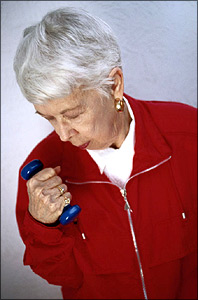Progression
 How To Progress
How To Progress
After the first week or so of strength training, you should start doing each exercise with weights that you can lift at least ten times with only moderate difficulty. (If a given exercise seems too difficult—if you cannot do at least eight repetitions—then the weight you are using is too heavy and you need to scale back.)
After two weeks of strength training, you should reassess the difficulty of each exercise with your current level of weights. You may start doing the overhead press with one-pound dumbbells, for example. By the end of the second week, the exercise may feel too easy—that is, you can easily lift the one-pound dumbbell through the full range of motion and in proper form more than twelve times. You should now step up your weights to two- or three-pound dumbbells and see how the exercise feels at the new weight level.
 Why
Progression Is Important
Why
Progression Is Important
To take full advantage of the many benefits of strength training, it's important to progress, or consistently advance the intensity of your workout by challenging your muscles with heavier weights. This continuous challenge allows your muscles to grow strong and stay strong. Progressing will boost your feelings of independence and will help ensure that you live well into old age without the fear of falling. It will also give you a tremendous sense of pride and accomplishment.
![]() Please note: Some of these publications are available for download only as *.pdf files. These files require Adobe Acrobat Reader in order to be viewed. Please review the information on downloading and using Acrobat Reader software.
Please note: Some of these publications are available for download only as *.pdf files. These files require Adobe Acrobat Reader in order to be viewed. Please review the information on downloading and using Acrobat Reader software.
* Links to non-Federal organizations found at this site are provided solely as a service to our users. These links do not constitute an endorsement of these organizations or their programs by CDC or the Federal Government, and none should be inferred. CDC is not responsible for the content of the individual organization Web pages found at these links.
Page last updated: May 22, 2007
Content Source: Division of Nutrition, Physical Activity and Obesity, National Center for Chronic Disease Prevention and Health Promotion
